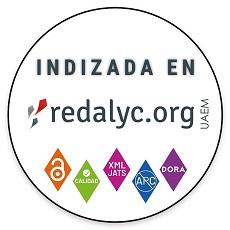
Publicado
Approach to model the influence of faults in a geothermal reservoir
Acercamiento a la modelación de la influencia de las fallas en un reservorio geotérmico
DOI:
https://doi.org/10.15446/dyna.v92n235.117079Palabras clave:
geothermal reservoir, production well, faults, HydroGeoSphere, Nevado del Ruiz (en)reservorio geotérmico, pozo de producción, fallas, HydroGeoSphere, Nevado del Ruiz (es)
Descargas
Two hydrogeological numerical models (2D and 3D) for the geothermal area located to the West of the Nevado del Ruiz volcanic complex (Colombia) are presented here. They are built with the software HydroGeoSphere using data collected in the field, as well as hydraulic and thermal properties measured on rock samples in previous laboratory studies. The purpose of this modeling work is to analyze the influence of faults aperture and depth on groundwater flow circulation and heat transfer in the geothermal reservoir. The 2D model illustrates the relation between fault aperture and temperature distribution. The 3D model shows the behavior of a potential production well located in the Botero-Londoño area that withdraws hot water from a depth of 2600 m. The results highlight the usefulness and limitations of this approach, providing guidelines for future numerical models of this site and for the initial modeling work for any fractured geothermal reservoir.
Se presentan aquí dos modelos numéricos hidrogeológicos (2D y 3D) para el área geotérmica situada al oeste del complejo volcánico Nevado del Ruiz (Colombia). Están construidos con el software HydroGeoSphere utilizando datos recolectados en campo, así como propiedades hidráulicas y térmicas medidas en muestras de roca en laboratorio, en estudios previos. El propósito de este trabajo de modelación es analizar la influencia de la apertura y profundidad de las fallas sobre la circulación del flujo de agua subterránea y la transferencia de calor en el reservorio geotérmico. El modelo 2D ilustra la relación entre la apertura de la falla y la distribución de la temperatura. El modelo 3D muestra el comportamiento de un pozo de producción potencial situado en la zona de Botero-Londoño que extrae agua caliente desde una profundidad de 2600 m. Los resultados demuestran la utilidad y las limitaciones de este estudio, proporcionando pautas para futuros modelos numéricos de este sitio y para las etapas iniciales de modelación de cualquier reservorio geotérmico fracturado.
Referencias
[1] IRENA. Global renewables Outlook: Energy transformation 2050, Ed. 2020, International Renewable Energy Agency, 2020. ISBN: 978-92-9260-238-3, 81 P.
[2] Kose, R., Geothermal energy potential for power generation in Turkey: a case study in Simav, Kutahya, Renewable and Sustainable Energy Reviews 11(3), pp. 497-511, 2007. DOI: https://doi.org/10.1016/j.rser.2005.03.005
[3] Paulillo, A., Cotton, L., Law, R., Striolo, A., and Lettieri, P., Geothermal energy in the UK: the life-cycle environmental impacts of electricity production from the United Downs Deep Geothermal Power project, Journal of Cleaner Production 249, art. 119410, 2020. DOI: https://doi.org/10.1016/j.jclepro.2019.119410
[4] Pruess, K., Modeling of geothermal reservoirs: fundamental processes, computer simulation and field applications, Geothermics 19(1), pp. 3-15, 1990. DOI: https://doi.org/10.1016/0375-6505(90)90062-G
[5] Hamm, V., and Sabet, B.B., Modelling of fluid flow and heat transfer to assess the geothermal potential of a flooded coal mine in Lorraine, France, Geothermics 39(2), pp. 177-186, 2010. DOI: https://doi.org/10.1016/j.geothermics.2010.03.004
[6] Shaik, A.R., Rahman, S.S., Tran, N.H., and Tran, T., Numerical simulation of Fluid-Rock coupling heat transfer in naturally fractured geothermal system, Applied Thermal Engineering 31(10), pp. 1600-1606, 2011. DOI: https://doi.org/10.1016/j.aplthermaleng.2011.01.038
[7] Bauer, J.F., Krumbholz, M., Luijendijk, E., and Tanner, D.C., A numerical sensitivity study of how permeability, porosity, geological structure, and hydraulic gradient control the lifetime of a geothermal reservoir, Solid Earth 10, pp. 2115-2135, 2019. DOI: https://doi.org/10.5194/se-10-2115-2019
[8] Caulk, R.A., Ghazanfari, E., Perdrial, J.N., and Perdrial, N., Experimental investigation of fracture aperture and permeability change within Enhanced Geothermal Systems, Geothermics 62, pp. 12-21, 2016. DOI: https://doi.org/10.1016/j.geothermics.2016.02.003
[9] Zucchi, M., Faults controlling geothermal fluid flow in low permeability rock volumes: an example from the exhumed geothermal system of eastern Elba Island (northern Tyrrhenian Sea, Italy), Geothermics 85, art. 101765, 2020. DOI: https://doi.org/10.1016/j.geothermics.2019.101765
[10] Taillefer, A., Guillou-Frottier, L., Soliva, R., Magri, F., Lopez, S., Courrioux, G., Millot, R., Ladouche, B., and Le-Golff, E., Topographic and faults control of hydrothermal circulation along dormant faults in an orogen. Geochemistry, Geophysics, Geosystems 19, pp. 4972-4995, 2018. DOI: https://doi.org/10.1029/2018GC007965
[11] Moreno, D., Lopez-Sanchez, J., Blessent, D., and Raymond, J., Fault characterization and heat-transfer modeling to the Northwest of Nevado del Ruiz Volcano, Journal of South American Sciences 88, pp. 50-63, 2018. DOI: https://doi.org/10.1016/j.jsames.2018.08.008
[12] Aquanty. HGS: HydroGeoSphere user manual, Aquanty Inc., 2013, 434 P.
[13] Vélez, M.I., Blessent, D., Córdoba, S., Lopez-Sanchez, J., Raymond, J., and Parra-Palacio, E., Geothermal potential assessment of the Nevado del Ruiz volcano based on rock thermal conductivity measurements and numerical modeling of heat transfer, Journal of South American Earth Sciences 81, pp. 153-164, 2018. DOI: https://doi.org/10.1016/j.jsames.2017.11.011
[14] González, H., Análisis de la nomenclatura estratigráfica de las rocas metamórficas (litodema A) al este del límite oriental de la zona de la Falla de Romeral, Cordillera Central Colombia, INGEOMINAS, 1989, 21P.
[15] González, H., Geología de las planchas 206 (Manizales) y 225 (Nevado del Ruíz), Memoria explicativa (Geology of the sheets 206 (Manizales) and 225 (Nevado del Ruiz), explicative memory), INGEOMINAS, 2001, 93P.
[16] Martínez, L.M., Valencia, L.G., Ceballos, J.A., Narváez, B.L.., Pulgarín, B.A., Correa, A.M., Navarro, S.R., Murcia, H.F., Zuluaga, I., Rueda, J.B., and Pardo, N., Geología y estratigrafía del Complejo Volcánico Nevado del Ruiz, Servicio Geológico Colombiano (SGC). 2014, 409P.
[17] Cervantes, C.A., 3D modelling and intrusion of the Nevado del Ruiz Volcano, Colombia. MSc. Thesis. Reykjavik University, Iceland. 2019.
[18] Betancurth M.G., y Gómez G.F., Contribución a la evolución hidrogeológica, susceptibilidad a fenómenos volcánicos, caracterización de áreas fuentes de sedimentos y morfoneotectónicas de las fallas probablemente activas en la Cuenca del Río Chinchiná (Caldas). Undergraduate Thesis, Universidad de Caldas, Manizales, Colombia. 1999.
[19] Naranjo-Henao, J.L., y Ríos-Alzate, P.A., Geología de Manizales y sus alrededores y su influencia en los riesgos geológicos, Revista Universidad de Caldas, 10(1-3), pp. 1-113, 1989. ISSN: 0120-1492.
[20] Ceballos-Gutiérrez, D., Análisis geológico y estructural detallado de una zona del Proyecto geotérmico en el valle de las Nereidas, macizo volcánico Nevado del Ruiz, para contribuir en el proceso de exploración geotérmica, CHEC. Undergraduate Thesis, Universidad de Caldas, Manizales, Colombia, 2017.
[21] Guzmán, G., Franco, G., and Ochoa, M., Proyecto para la mitigación y el riesgo sísmico de Pereira, Dosquebradas y Santa Rosa. Evaluación Neotectónica. CARDER. Pereira, 1998, 144P.
[22] Oviedo, M.J., Blessent, D., López-Sánchez, J., and Raymond, J., Contribution to the characterization of the Nevado del Ruiz geothermal conceptual model based on rock properties dataset. Journal of South American Earth Sciences, 124, art. 104259, 2023. DOI: https://doi.org/10.1016/J.JSAMES.2023.104259
[23] HydroAlgorithmics. AlgoMesh user guide, HydroAlgorithmics Pty Ltd., 2016, 257P.
[24] Bernal, N.F., Ramírez, G., and Alfaro, C.V., Mapa geotérmico de Colombia. Versión 1.0 Escala 1:1’500.000. Memoria explicativa: exploración y evaluación de recursos geotérmicos INGEOMINAS, 2000, 44P.
[25] Alfaro, C., Alvarado, I., and Manrique, A., Heat flow evaluation at Eastern Llanos sedimentary basin, Colombia, in: Proceeding World Geothermal Congress, 2015, pp. 1-9.
Cómo citar
IEEE
ACM
ACS
APA
ABNT
Chicago
Harvard
MLA
Turabian
Vancouver
Descargar cita
Licencia
Derechos de autor 2025 DYNA

Esta obra está bajo una licencia internacional Creative Commons Atribución-NoComercial-SinDerivadas 4.0.
El autor o autores de un artículo aceptado para publicación en cualquiera de las revistas editadas por la facultad de Minas cederán la totalidad de los derechos patrimoniales a la Universidad Nacional de Colombia de manera gratuita, dentro de los cuáles se incluyen: el derecho a editar, publicar, reproducir y distribuir tanto en medios impresos como digitales, además de incluir en artículo en índices internacionales y/o bases de datos, de igual manera, se faculta a la editorial para utilizar las imágenes, tablas y/o cualquier material gráfico presentado en el artículo para el diseño de carátulas o posters de la misma revista.

















